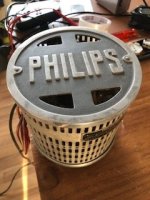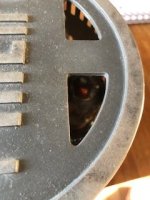High production costs for both. Burr Brown for the on chip calibration. Even when weighing words it still can go wrong in expression.
Not surprising as this was new technology and customers needed to be convinced of the higher quality and longevity. No manufacturer could afford to tarnish its reputation by producing fast dying stuff. A little different from today 🙂
Same counted for the CDM mechs at Philips. More expensive to produce in a competitive market (and too good quality in mind). The fact that a great lot of them still function OK (except for the mediocre Philips electrolytic cap quality) after decades is a sign.
Not surprising as this was new technology and customers needed to be convinced of the higher quality and longevity. No manufacturer could afford to tarnish its reputation by producing fast dying stuff. A little different from today 🙂
Same counted for the CDM mechs at Philips. More expensive to produce in a competitive market (and too good quality in mind). The fact that a great lot of them still function OK (except for the mediocre Philips electrolytic cap quality) after decades is a sign.
Last edited:
Off topic: talking about longevity, in Grimeton, Sweden they just celebrated the 100th birthday of the machine transmitter there by transmitting a Morse code message with the original 1924 transmitter. The message was written by a grandchild and greatgrandchild of the designer of the transmitter.
"Bitstream" DACs are inherently superior.
Time is more accurate than resistance.
They have their own set of problems, issues with idle tones that get frequency-modulated by the signal, for example. Of course there are also workarounds for those.
They could do that. But trimming is still an expensive process. They'd have to test the parts at least twice: Once before trim and once after. They'd likely run the wafers through sort too, to ensure that they don't package the obvious duds. So that's three test steps. Plus the E-trim step. That's a lot of cost. They'd need a customer who's willing to bear that. And, sadly, a bunch of DIYers wanting free samples doesn't make for a good business case... 🙂
Tom
The problem is volume, TI make high volume parts, and R-2R audio DACs are not high volume.... Otherwise the e-trim process is inexpensive, it's done during testing, TI sell $0.50 opamps using e-trim....
Turning out TDA1541s was never going to keep the lights on.It really is a pity what Philips has become.
Quality of audio gear. Innovations in HiFi. To name a few.
I recently understood Philips doesn’t even produce audio and TV sets itself anymore.
I recently understood Philips doesn’t even produce audio and TV sets itself anymore.
Philips just make medical equipment, not all of which works, as far as I know. And maybe shavers?
Lamps are now made by Signify, semiconductors by NXP and Nexperia, lithographic equipment by ASML.
Lamps are now made by Signify, semiconductors by NXP and Nexperia, lithographic equipment by ASML.
A part that requires trim is always more expensive to make than one that doesn't. A part that requires trim in one place (like Vos on an opamp) costs less to trim than one that requires trim in many places.The problem is volume, TI make high volume parts, and R-2R audio DACs are not high volume.... Otherwise the e-trim process is inexpensive, it's done during testing, TI sell $0.50 opamps using e-trim....
The test time is the silent killer. Time is money. If the tester has to wait for an 8.5-digit DMM to settle to ppm precision it'll have to wait for quite a while. If it has to do so for each of the 23-24 bits test time will kill the product.
"eTrim is done during test"... Yeah... Maybe. Or maybe it works like laser fuse trim where dice on a wafer are tested at one station, sent elsewhere for trim, and then retested. So now you're dealing with three insertions, which means you have to worry about bond pads wearing out from repeated probe hits.
I've not worked on a product that had eTrim. Only laser fuse trim. Maybe eTrim is a more efficient process.
There's also the question of why. Why spend money developing an expensive R2R DAC when you can get better performance with a delta-sigma DAC? The PCM1704 is a nice R2R DAC, but easily beat on many specs by the PCM1792, which isn't exactly new either. There needs to be a solid business reason for TI to pursue another R2R DAC and "R2R DACs make me feel all warm and fuzzy inside" is not a good business reason. But hey... That leaves a small hole in the market that a small manufacturer like yourself can go and fill. So good on ya for doing that! 🙂
Tom
Yes the electric shavers are their prime (consumer) product. Still made in the Netherlands too.Philips just make medical equipment, not all of which works, as far as I know. And maybe shavers?
Lamps are now made by Signify, semiconductors by NXP and Nexperia, lithographic equipment by ASML.
They have probably directed that talent at something more profitable.Quality of audio gear. Innovations in HiFi. To name a few.
Of course, can't blame them but is is a pity after such nice inventions. A TV by Philips was made to last. As a student I got free K12 ones that were abandoned at the curbstone to be picked up by the garbage service. Always got them going for at least another 5 years.
Consumer electronics will likely be practically 100% chinese. There is something good and something bad about that.
Consumer electronics will likely be practically 100% chinese. There is something good and something bad about that.
Last edited:
The big problem... In France, Europe and elsewhere... It's the shareholders who only think about collecting dividends to the detriment of research and development!Of course, can't blame them but is is a pity after such nice inventions. A TV by Philips was made to last. As a student I got free K12 ones that were abandoned at the curbstone to be picked up by the garbage service. Always got them going for at least another 5 years.
Consumer electronics will likely be practically 100% chinese. There is something good and something bad about that.
They don't care... they have the money and we have the rest... 😳
i have tried a hundred of dacs and not all R2R sounds the same , some are better than the deltasigma some not . but all sabre dac i have heard sounds like crap 

It is a little more complicated than that.The big problem... In France, Europe and elsewhere... It's the shareholders who only think about collecting dividends to the detriment of research and development!
They don't care... they have the money and we have the rest...
- Home
- Source & Line
- Digital Line Level
- Are R2R DACs inherently better?

